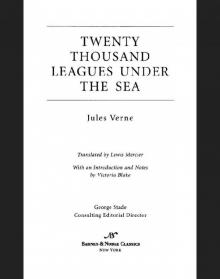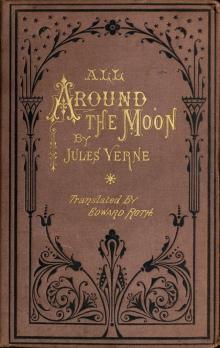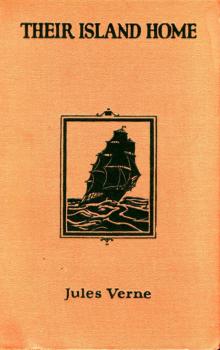- Home
- Jules Verne
City in the Sahara - Barsac Mission 02
City in the Sahara - Barsac Mission 02 Read online
Library of Congress Cataloging in Publication Data
Verne, Jules, 1828-1905. The Barsac mission.
Translation of L'etonnante aventure de la mission Barsac.
Reprint of the 1960 ed. published by Ace Books, New York.
CONTENTS: book 1. Into the Niger bend, book 2. The city in the Sahara. I. Title.
[PZ3.V594Bar7] [PQ2469] 843'.8 76-48161
ISBN 0-88411-911-4 (v. 1)
ISBN 0-88411-912-2 (v. 2)
INTRODUCTION
Book 1 of Jules Verne's posthumous story, L'Etonnante Aventure de la Mission Barsac, published in this series under the title Into the Niger Bend, described the vicissitudes of the Barsac Mission, sent out at the beginning of the Nineteenth Century to ascertain whether the Negroes of French West Africa were qualified to become voters and citizens. After being threatened and impeded, robbed of its armed escort and of its native porters, its members were pounced on in mysterious circumstances, pinioned, and threatened with death.
Accompanying the Mission was a young English girl, Jane Blazon, passing under the pseudonym of Jane Momas. With her elderly nephew, Agenor de St. B6rain, she had undertaken the journey to clear the name of her brother, George Blazon, accused of having turned traitor and led the native troops he commanded in murderous attacks on the Negroes. In his grave at Koubo she found evidence of his innocence; instead of having been shot down by a punitive expedition, as was alleged, he had been deliberately murdered from behind by some unknown assassin, who was presumably guilty of the Blazon column's atrocities.
By taking this news to her father, Lord Blazon of Glenor, Jane hoped to restore the old man's peace of mind, shattered by this stain on the family honour, but the kidnapping of the Mission had precluded this. Meantime, unknown to her, Lewis Blazon, also her brother, had vanished after a bank robbery in which he was suspected of complicity.
The events which followed the kidnapping of the Barsac Mission and of Jane Blazon are described in the present volume. They illustrate Jules Verne's inventive genius as well as his ability to keep abreast of the latest scientific and technical advances and to weave them into his narrative. Unpublished until after his death in 1905, the stoiy incorporates inventions made towards the end of his life, notably that of wireless telegraphy. It shows that he shared in the contemporary belief, not justified by events, that liquid air was the motive power of the future. But it also illustrates his remarkable powers of foresight in his description of rocket-propelled missiles, aircraft with a vertical take-off and automatic stabilizers, and the attempt to control the weather by inducing passing clouds to discharge themselves in rain.
He was plainly aware of early experiments with airplanes, and may have known of the achievements of the Wright Brothers. Yet Verne himself had pinned his faith not to the airplane but to the helicopter.* An attempt to take advantage of both types may have produced the aircraft which he called Flaneurs— though their nature is more graphically expressed by the term I have substituted.
As in Book I the names of some of the characters have been altered to avoid a possible clash with those (See, for example his account of its advantages over other types of aircraft in his story, The Clipper of the Clouds.) of actual people. But the titles of this mysterious city, of its varied inhabitants, and of its ruler, are those given by the author himself.
In my introduction to Book I, I put forward a possible reason why so remarkable a work does not seem to have been hitherto translated into English. The continuation of the narrative suggests another, that at the time it seemed too far fetched even for Jules Verne.
In those orderly days the notion of a super-scientific community ruled by criminals seemed beyond the bounds of possibility. We have seen such communities (not mere cities but nations) compared to which the City in the Sahara seems almost tame.
Here Verne's prophetic gifts misled him only by falling short of the truth. Yet the story remains an example of the symbolism which he could use so effectively. His Blackland typifies much in our civilization, its triumphs of technology and its material advances compared with its backwardness (indeed with its retrogression) in moral and spiritual development, the threat implicit in its very nature that the misuse of its mighty powers will end in its own destruction.
Nevertheless his strong religious faith forbade Verne to despair of humanity. The stronghold of material progress may be shattered, but from its ruins come the decent people, the gentle and humble of heart, preserved (humanly speaking) by their idealism, their sense of duty, their moral integrity, and their mutual faith.
CHAPTER I
BLACKLAND
At the beginning of the century even the most accurate and recent of maps represented the Sahara, that immense stretch of nearly 300,000 square miles, only by a blank space. When the Mission led by the Deputy Barsac underwent the trials described in the first part of this narrative, nobody had crossed it, nobody had entered it. It was completely unknown.
At that time, the strangest legends circulated about that unexplored region. Sometimes, so the natives said, they had seen immense black birds with outspread wings and fiery eyes flying towards or into these arid plains. Sometimes a horde of great red devils, mounted on plunging horses whose nostrils emitted flames, had suddenly emerged from that mysterious land. These uncanny horsemen galloped into the towns, slaying, massacring all whom they found in their way, then returning to the desert, and carrying across their saddles men, women, and children who never returned.
Who were these miscreants who destroyed the villages, pillaged the huts, looted the miserable treasures of the poor Negroes, and disappeared, leaving behind them ruin, despair and death? Nobody knew. Nobody had tried to find out. Who, indeed, would dare to follow enemies believed to be endowed with supernatural powers, the fierce deities of the desert?
Such were the rumours which spread along the Niger, and as far as a hundred miles from its bank.
If, more daring than these timid Negroes, someone had ventured into the desert, and if this hero had reached, at the cost of a journey of over 150 miles, a point 1°40/ east and 15° 50' north, he would have reaped the reward of his courage. He would have seen something that nobody had ever seen before, neither the explorers nor the caravans: a city.
Yes, a town, a real town, which did not appear on any map, and of which nobody suspected the existence, although its total population, not counting children, was not less than 6,808.
If the hypothetical traveller had asked the name of the town, and if one of its inhabitants had been willing to tell him, he would perhaps have said in French "le nom de cette ville est Terre-noire": but he would be just as likely to reply in Italian "Questa citta di Terra Nera"; in Bambara, "Ni dougouba ntocko a be Bankou Fing"; in Portuguese, "Hista ciudad e Terranegra"; in Spanish, "Esta ciudad es Tierranegra." But no matter in what the language, all the answers would have meant: "The name of this city is Blackland."
The information might even be given in Latin: "Ista urbs Terra Nigra est." The enquirer would simply be dealing with Josias Eberly, a one-time professor who, having found in Blackland no use for his erudition, had opened a shop and become, as his sign somewhat unidiomatically indicated, "Josias Eberly, Druggist, Products for Dye."
Every language was spoken in this new Tower of Babel, whose population, when the Barsac Mission collapsed near Koubo, comprised, apart from 5,778 Negroes and Negresses, 1,030 whites. Though these had come from all parts of the world, most of them had one thing in common; escaped from the hulks or the prison, they were adventurers capable of anything except the right, outcasts ready for the worst jobs. However, just as in that motley crowd representatives of the English race predominated, so the Engli
sh language took precedence. It was in English that the Chief published his proclamations and the local government, so far as there was a local government, its decrees; and the town's official journal was The Blackland Thunderbolt.
Very remarkable that journal, as can be judged from extracts from several issues:
"Today John Andrew hanged the Negro Koromoko, who had forgotten to bring him his after lunch pipe."
"Tomorrow evening, at six. ten heliplanes will set out for Kourkoussou and Bidi, with ten Merry Fellows commanded by Colonel Hiram Herbert. Total raid on these two villages, which we haven't visited for three years; return the same night."
"We have learned that a French Mission, directed by a Deputy called Barsac, is soon to set out from Konakry. This Mission had, it appears, the intention of reaching the Niger by way of Sikasso and Ouagha-dougou. We have taken precautions. Twenty of the Black Guard and two Merry Fellows will keep in touch with them continually. Captain Edward Rufus will join them at some convenient time. Rufus who, as we know, is a deserter from the Colonial Infantry, will play, under the name of Lacour, the role of a French lieutenant, and will take advantage of his command of that nation's military usages, so as to check, somehow or other, the said Barsac, making certain that he does not reach the Niger."
"Today on the Garden Bridge, as the result of a discussion, Counsellor Ehle Willis found himself under the necessity of putting some bullets into the head of Merry Fellow Constantin Bernard. The latter fell into the Red River, where, borne down by the abnormal weight of his skull, so recently filled with lead, he was drowned. A session was at once opened to replace the deceased. It was Gilman Ely who received this honour, having seventeen .sentences inflicted by the courts of France, England and Germany, and achieved the total of 29 years in prison and 35 years in the hulks. Gilman Ely will thus be transferred from the Civil Body to the Merry Fellows. Our best wishes go with him."
It will be seen that the personages in question were designated only by their forenames. This was the custom in Blackland, where every new arrival lost his family name, which was known only to the Chief. Alone among the white inhabitants, apart from a special group to be described later, that Chief was known in the ordinary wav. Even then his name must have been a nickname, at once terrible and sinister. He was called Harry Killer.
Ten years before the remains of the Barsac Mission had been rounded up as explained in part 1 of this book, Harry Killer, coming from nobody knows where with several others of the same kidney, had reached that part of the desert where Blackland was to rise. There he had pitched his tent and said "The town will be here." And Blackland had arisen from the sand as though by enchantment.
It was a remarkable place. On level ground, on the right bank of the Tafasasset Oued, a gully dry until the decree of Harry Killer filled it with water, it was built in a precise semicircle, measuring exactly 1200 yards from north-east to south-west parallel to the stream and 600 yards from north-west to south-east. Its surface thus comprised over a hundred acres and was divided into three unequal sections, bounded by unscalable semicircular walls of compressed clay, over thirty feet high and almost as thick at their base.
Nearest the banks of the stream, renamed the Bed River by Harry Killer, the first section had a radius of two hundred and fifty yards. A boulevard a hundred yards wide extended from the points where it joined the second section along the river bank as far as the third. This increased its surface to about thirty five acres.
In the first section lived the aristocracy of Blackland; these were called, by way of antithesis, the Merry Fellows. Except for a few meant for higher destiny, Harry Killer's original companions had been the embryo of this corps. Around this nucleus had soon gathered a horde of bandits, escaped from prison or the hulks, to whom Killer had promised full satisfaction of their detestable instincts. Soon the Merry Fellows had grown to number 566, a total not to be exceeded on any pretext.
Their functions were numerous. Organized on military lines, with a colonel, five captains, ten lieutenants and fifty sergeants, respectively commanding five hundred, one hundred, fifty, and ten men, they formed the army of Blackland and levied war. A war devoid of honour, moreover, a war of loot, consisting only of pillaging the wrecked villages and of massacring or enslaving all their inhabitants. The Merry Fellows also acted as the police of the town; by blows (except when they used their revolvers) they controlled the slaves who performed the agricultural and other work. But above all they formed the Chiefs bodyguard and obeyed his orders blindly.
The town's third section, the most distant from the centre, formed a semicircular arc, about six hundred yards long and fifty wide. Its two extremities abutted on the first section and on the Red River, and it followed the circuit of the town, between its outer boundary, and that of the second section, where the slaves were parked.
In this third section there lived, under the general name of the Civil Body, the whites not permitted in the first. While waiting for a place to become vacant in this (which did not take very long, for the brutal customs of Blackland caused frequent deaths) they spent their time in the Civil Body, which could thus be considered as a purgatory whose paradise would be the Merry Fellows.
To subsist until then, for only the Merry Fellows were supported by the Chief and the town's communal activities, they went in for trade. Their section was thus the commercial quarter of the town, and it was there that the Merry Fellows could buy countless products, including the most luxurious. These the merchants bought from the Chief, who gained them either as plunder or else, as regards articles of European origin, by methods known only to himself and his immediate entourage.
This third section comprised 246 inhabitants, including 45 white women, who were worth no more than their male fellow citizens of the same colour.
Between the first and the third section was the second, with a surface of about 63 acres. This was the slaves' quarter, their number then being 5,778, of which 4,196 were men and 1,582 women. It was there, almost without exception, that they dwelt. There were their huts. There they spent their wretched lives.
Each morning the four doors in its wall opened, and, driven by Merry Fellows armed with bludgeons and guns, those of the Negroes who were not busied with the town's upkeep went, by brigades, to the agricultural work. In the evening the miserable herd returned in the same manner, and the heavy doors closed until the next day. There was no exit to the outer world. On one side the Merry Fellows, on the other the Civil Body. On all sides being equally bloodthirsty and equally fierce.
Many of these wretches died, either from the privations they suffered, or under the blows of their guardians too often transformed into murderers. This was a trifling misfortune. Another raid would soon fill the gaps, and other martyrs would replace those freed by death.
But these districts on the right bank did not form the whole of Blackland. On the left bank of the Red River the ground rose abruptly to form a hill about fifty yards high. Here the outer wall extended, marking out a rectangle twelve hundred yards along the riverside and three hundred yards from its banks. This second town, scarcely smaller than the first, for it covered about seventy acres, was itself divided into two equal parts by a high transverse wall.
One of these halves, on the north-east slope of the hill, had been converted into the Fortress Garden, a public park communicating at its northern end, by means of the Garden Bridge, with the sections occupied by the Merry Fellows and the Civil Body. The other half, placed on the summit, contained the vital organs of the city.
In the northern corner, beside the public garden, rose a huge quadrangular construction, surrounded by flanking walls; its north-west face towered over the Red River from a height of about ninety feet. Usually called the Palace, this was the home of Harry Killer and nine of his companions, promoted to the rank of Counsellors. Strange Counsellors, the habitual accomplices in their Chief s crimes. Strange Counsellors, whose chief function was the immediate execution of the orders of a master who was inaccessible and
almost always invisible, and from whose sentences there was no appeal.
Another bridge, barred by a solid grille during the night, the Castle Bridge, connected the seat of government with the right bank.
To the Palace were annexed two barracks. One was assigned to a dozen slaves who acted as servants, and also to fifty Negroes, chosen from those who seemed to have the fiercest natural instincts, and who formed the Black Guard. In the other lived forty whites selected on the same principle; to these was confided the use of the flying machines spoken of in Blackland as heliplanes.
A wonderful invention of a brain of genius, these heliplanes were powerful machines, able to travel without refuelling up to three thousand miles at an average speed of two hundred and fifty miles an hour. To these heliplanes the pirates of Blackland owed the gift of ubiquity which they seemed to possess, enabling them to vanish as soon as a crime was committed. On these heliplanes the despotic power of Harry Killer chiefly rested.
It was indeed by terror that he governed the unknown empire of which Blackland was the capital, by terror that he had established and maintained his authority. Nevertheless the autocrat had not failed to foresee a revolt of his subjects, black or white. Prudently he had so placed the Palace that it dominated and threatened with its guns the town, the garden, and the barracks. Any revolt would be the signal for a massacre, from which there would be no escape. The desert formed an insuperable barrier, and anyone who entered that robber's lair must forever renounce all hope of coming out.
For the rest, Blackland was kept perfectly clean, and well maintained, and was provided with every possible commodity. Not a house of the Merry Fellows or the Civil Body which did not have its own telephone. Not a street, not a house,not even a hut in the slaves' quarters, which did not enjoy water from the mains, and which was not lighted by electricity.

 Michael Strogoff; Or the Courier of the Czar: A Literary Classic
Michael Strogoff; Or the Courier of the Czar: A Literary Classic Voyage au centre de la terre. English
Voyage au centre de la terre. English Journey Through the Impossible
Journey Through the Impossible The Castaways of the Flag
The Castaways of the Flag L'île mystérieuse. English
L'île mystérieuse. English Maître du monde. English
Maître du monde. English Around the World in Eighty Days
Around the World in Eighty Days A Voyage in a Balloon
A Voyage in a Balloon From the Earth to the Moon, Direct in Ninety-Seven Hours and Twenty Minutes: and a Trip Round It
From the Earth to the Moon, Direct in Ninety-Seven Hours and Twenty Minutes: and a Trip Round It Paris in the Twentieth Century
Paris in the Twentieth Century City in the Sahara - Barsac Mission 02
City in the Sahara - Barsac Mission 02 The English at the North Pole
The English at the North Pole The Field of Ice
The Field of Ice From the Earth to the Moon
From the Earth to the Moon Un capitaine de quinze ans. English
Un capitaine de quinze ans. English The Mysterious Island
The Mysterious Island Les indes-noirs. English
Les indes-noirs. English Robur-le-conquerant. English
Robur-le-conquerant. English Propeller Island
Propeller Island Around the World in Eighty Days. Junior Deluxe Edition
Around the World in Eighty Days. Junior Deluxe Edition Les forceurs de blocus. English
Les forceurs de blocus. English In the Year 2889
In the Year 2889 Journey to the Centre of the Earth
Journey to the Centre of the Earth Twenty Thousand Leagues Under the Sea
Twenty Thousand Leagues Under the Sea From the Earth to the Moon; and, Round the Moon
From the Earth to the Moon; and, Round the Moon Vingt mille lieues sous les mers. English
Vingt mille lieues sous les mers. English Cinq semaines en ballon. English
Cinq semaines en ballon. English Twenty Thousand Leagues under the Seas
Twenty Thousand Leagues under the Seas Face au drapeau. English
Face au drapeau. English Michael Strogoff; Or, The Courier of the Czar
Michael Strogoff; Or, The Courier of the Czar Un billet de loterie. English
Un billet de loterie. English The Secret of the Island
The Secret of the Island Off on a Comet! a Journey through Planetary Space
Off on a Comet! a Journey through Planetary Space Into the Niger Bend: Barsac Mission, Part 1
Into the Niger Bend: Barsac Mission, Part 1 All Around the Moon
All Around the Moon A Journey to the Center of the Earth - Jules Verne: Annotated
A Journey to the Center of the Earth - Jules Verne: Annotated 20000 Lieues sous les mers Part 2
20000 Lieues sous les mers Part 2 Robur-le-Conquerant
Robur-le-Conquerant Les Index Noires
Les Index Noires Michael Strogoff; or the Courier of the Czar
Michael Strogoff; or the Courier of the Czar 20000 Lieues sous les mers Part 1
20000 Lieues sous les mers Part 1 Twenty Thousand Leagues Under the Sea (Barnes & Noble Classics Series)
Twenty Thousand Leagues Under the Sea (Barnes & Noble Classics Series) Five Weeks In A Balloon
Five Weeks In A Balloon Journey to the Center of the Earth
Journey to the Center of the Earth 20,000 Leagues Under the Sea
20,000 Leagues Under the Sea Journey to the Center of the Earth (Barnes & Noble Classics Series)
Journey to the Center of the Earth (Barnes & Noble Classics Series) Adrift in the Pacific-Two Years Holiday
Adrift in the Pacific-Two Years Holiday The Collected Works of Jules Verne: 36 Novels and Short Stories (Unexpurgated Edition) (Halcyon Classics)
The Collected Works of Jules Verne: 36 Novels and Short Stories (Unexpurgated Edition) (Halcyon Classics) The Survivors of the Chancellor
The Survivors of the Chancellor Their Island Home
Their Island Home Le Chateau des Carpathes
Le Chateau des Carpathes Les Cinq Cents Millions de la Begum
Les Cinq Cents Millions de la Begum The Floating Island
The Floating Island Cinq Semaines En Ballon
Cinq Semaines En Ballon Autour de la Lune
Autour de la Lune